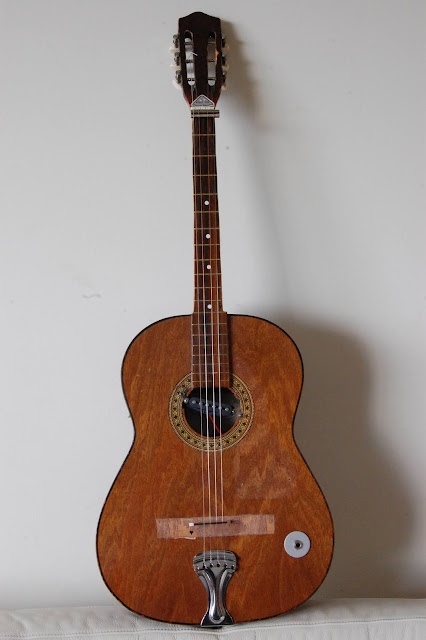I found this paint-stripped Silvertone 1405, made in Japan, in two pieces at Exile Guitars on Main Street in Vancouver.
I paid $60 for it. There was a neck, a body, and a pickguard with the microphonic pickup, a tone and volume knobs with a capacitor for eq, and the jack.
I melted a candle over the back of the pickup to try to stop the microphonic feedback. It worked. The hot wax melted the wax in the pickup and filled up the rest of the volume in the pickup case. I'm sure there's lots of air bubbles in it but it worked.
There was no neck plate. So I used washers and wood screws. Not pretty but it worked.
I purchased the tailpiece, bridge, and tuners from Amazon.ca.
Even though the tuners were small (9mm), I still had to drill out the headstock holes to make each post hole 1 mm wider. I believe the holes were nominally correct but wood shrinkage made the holes smaller by just a wee. You might not have this problem with 9mm post replacement parts.
The bridge and tailpiece: https://www.amazon.ca/dp/B09J4D35WY
It was made in March 1969 and was date-stamped on the back of the pickguard.
The pickup is single coil and super CURVED. This creates a volume balance problem as the neck radius is relatively smaller. The G string can get quite loud compared to both E strings. You have to tilt one away to get balance on the other E. But it comes at the expense of the volume of that original E string.
I am considering replacing with a flatter single coil.
There is not a lot of info on this model so I thought I'd list the basics for folks who are considering getting one or want to know more about theirs.
Scale length - bridge to zero fret: 24 3/4"
Fret width at zero fret: 1 5/8"
Upper bout: 10 1/2"
Lower bout: 12"
Tuning post: 9mm
All total I spent $140 to get this guitar and fix it to a playable condition.
Note the body cavity has room only for that single middle position and it is narrow. A humbucker or gold foil won't fit.
I had hoped there would be more spaces under the pickguard for a bridge pickup but no dice.
I'm still trying to decide if I should rout out room for one.













































